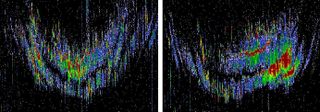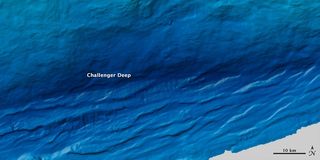The 10 Strangest Science Stories of 2016

Strange science

News of alien planets, strange sounds from the seafloor and a bizarre new state of matter turned 2016 into a strange year, scientifically speaking.
The weirdest discoveries of 2016 ran the gamut from relatively academic (unexpected discoveries in quantum physics) to very relevant to daily life on Earth (the Arctic's unusual, melty behavior).
Here's a rundown of the oddest and most surprising scientific discoveries of the past year.
Light's new momentum

The speed of light (186,000 miles per second, or 299,792 kilometers per second) hasn't changed, but a report in May revealed that another of light's basic properties might not be as basic as scientists once believed.
While doing some calculations based on a 200-year-old discovery, physicists at Trinity College Dublin found that light particles — photons — weren't behaving as they should. When shone through particular crystals in order to force the light beams into a hollow tube of light, the photons spun at an angular momentum of one-half of Planck's constant. Planck's constant is one of those basic numbers in physics. It determines the relationship between a wavelength of light and its energy.
What surprised physicists is that photons shouldn't be able to spin at a speed that's one-half Planck's constant. All photons are supposed to spin at speeds that are whole-number values of Planck's constant (twice Planck's constant, or three times Planck's constant, but not half of Planck's constant). Another class of particles, fermions, can spin at fractions of Planck's constant.
"Our result shows that we can make beams of photons, which behave like fermions — a completely different form of matter," Trinity College physicist Kyle Ballantine told Live Science at the time.
The finding doesn't mean that quantum physics is wrong, the researchers said, but it does mean that something about light works differently than they'd thought.
Echoes in the atmosphere

In 1962, researchers at the Jicamarca Radio Observatory in Peru noticed something weird: Some of the radio waves they were beaming into space were bouncing back. It was as if there were some sort of reflector in the upper atmosphere, about 80 to 100 miles (130 to 160 kilometers) up. But the reason for the echoes remained a mystery until 2016. It took supercomputers to solve it. Researchers simulated the upper atmosphere and found that the echoes owe their existence to the sun. When sunlight hits the ionosphere, where the echoes originate, they strip electrons from the molecules in that atmospheric layer. The resulting, highly energetic charged particles zip through the masses of cooler particles around them, causing those cooler particles to vibrate like strings on a cello. The vibrations aren't particularly organized, the researchers said, but they create a low-level "froth" that's strong enough to bounce back the Jicamarca radio waves.
Ancient reptile with an anteater claw

Two hundred million years ago, a chameleon-like reptile named Drepanosaurus roamed the land. Paleontologists first found the fossils of the 1.6-foot-long (0.5 meters) reptile in Italy in the 1970s, but it wasn't until this year that they realized just how strange this animal really was.
The weirdness is all in the arms. New fossils found in New Mexico revealed Drepanosaurus' front limbs in three-dimensional detail for the first time. Unlike all other four-limbed creatures (known as tetrapods), Drepanosaurus had a crescent-shaped ulna — one of the bones of the forearm.
Tetrapods generally follow the same body pattern: Each of their front limbs has an upper-arm bone (the humerus) and two lower-arm bones (the ulna and radius). Drepanosaurus' version of these bones was unlike anything scientists had seen before. The lizard also had abnormally long wrist bones.
The limbs, along with a hook-like claw, would have allowed Drepanosaurus to dig and drag dirt like a modern anteater, the researchers reported in September in the journal Current Biology.
Dancing electrons in a new form of matter

It's not every year physicists discover a new form of matter, but 2016 was one of those years.
To be specific, the researchers actually created the new form of matter by bombarding sheets of alpha ruthenium chloride with neutrons. This created something called a Kitaev quantum spin liquid, which looks solid — you could hold a chunk of it in your hand — but contains electrons that dance about as if they were in a liquid.
Physicists had theorized about quantum spin liquids for decades. One of those theorists, Alexei Kitaev of the California Institute of Technology, predicted a form of matter in which the electrons would interact as if they were Majorana fermions, a type of particle that acts as its own antiparticle (a particle of the same mass but an opposite charge). Scientists at Oak Ridge National Laboratory in Tennessee decided to test this theory and found that their neutron-bombarded alpha ruthenium chloride did in fact behave in this way.
In the new form of matter, the orientation (or spin) of the electrons affects the orientation of other electrons, but these electrons still remain chaotic no matter how cold the material becomes, the researchers reported. The electrons don't actually fragment into particles and antiparticles as in Majorana fermions, but their spin interactions make it look as if they do, so researchers call them "quasiparticles." The material might be useful for increasing the reliability of quantum computing.
A brand-new neighbor

Earth may have had a next-door neighbor all along. This August, scientists announced that they'd detected a tiny disturbance in the light coming from Proxima Centauri, the closest star to Earth besides the sun.
The disturbance indicates the presence of a planet in the red dwarf star's habitable zone, meaning life could theoretically exist there. Models based on the planet's distance from its star and its mass (1.3 times that of Earth's) suggest that it might have an atmosphere and be entirely covered by a deep ocean, which would be potentially amenable to life. But there are multiple theories about the planet's atmosphere and environment and little hard data, so aliens are far from a foregone conclusion.
As of Dec. 1, astronomers have confirmed the existence of 3,431 exoplanets, or planets outside Earth's solar system, according to the NASA Exoplanet Archive. Two hundred and ninety-seven confirmed or suspected planets in the habitable zones of their stars have been discovered so far, according to the Archive.
Strange red spot

Closer to home, a big red spot festoons the north pole of Charon, Pluto's largest moon. In September, researchers announced that they'd figured out where this colorful blemish comes from: Pluto's atmosphere.
Pluto is a tiny planet, and since it doesn't have a strong gravitational pull, its atmosphere radiates out into space. When the New Horizons spacecraft flew by Pluto and its moons in 2015, the red spot on Charon was immediately apparent. Scientists thought that it might be a result of the moon gravitationally capturing some of Pluto's lost atmospheric gases.
By modeling the temperatures Pluto and Charon over time, the researchers confirmed their hunch. Charon's winters last more than 100 Earth years, and they are frigid — temperatures hover around absolute zero (minus 459.67 degrees Fahrenheit, or minus 273.15 degrees Celsius). Methane from Pluto's atmosphere gets frozen at Charon's frigid poles. There, cosmic radiation strips away the hydrogen from the methane, leaving only carbon behind. These carbon atoms link up to create incredibly complex organic compounds called tholins, which make up Charon's red spot.
One odd head

Throughout history, some cultures have gone to extreme lengths for beauty, including practices that involved flattening or reshaping the skull. The skull of a woman from Korea's ancient Silla culture appeared to have come by its odd shape naturally, though.
Anthropologists reported their strange find in June after excavating the skeleton of a woman from a traditional burial site near Gyeongju, the capital of the Silla Kingdom (57 B.C. to A.D. 935) on the Korean peninsula. The woman, who died in her late 30s, had an elongated head, with its length being more than 75 percent of its width, the researchers reported. The term for this head shape is dolichocephalic.
It's plausible that the people who inhabited Silla performed cranial shaping, the researchers told Live Science, but the woman's bones showed no signs of flattening or of compensatory growth on the side of the skull — which is usually seen when boards or bricks are used to alter the skull of a baby or growing child. It's likely, they concluded, that the woman's head was just part of a normal variation. [See Images of the Long-Headed Woman's Facial Reconstruction]
Unprecedented heat in the Arctic

It's been a strange year at the North Pole. Temperatures have hit all-time highs (the North Pole was 36 degrees F, or 20 degrees C, above normal in November 2016). And ice hasn't expanded in the winter season as it usually does when the temperature dips. This December, data from the National Snow and Ice Data Center showed that the Arctic was missing a chunk of sea ice the size of Mexico — and that sea ice had actually retreated in November. The ice declined by 19,300 square miles (50,000 square kilometers), vastly outpacing the only other November ice retreat ever seen, which is a loss of 5,400 square miles (14,000 square km) in 2013. Ultimately, the November sea-ice extent ended at 753,000 square miles (1.95 million square km) below the 1981-to-2010 long-term average for the month, the NSIDC reported.
In some ways, the warm temperatures and lack of ice aren't surprising. Scientists have long known that the Arctic is particularly vulnerable to climate change, and the region is warming twice as fast as the rest of the world, on average. At current rates of warming, scientists expect that the Arctic will be ice-free in midsummer by the middle of the century.
Sticky traps made of … pee?

The larvae of a cave fungus gnat (Arachnocampa) are well-known weirdos. They glow, for one thing — thus, their common name, glowworms — and they also live in tubes that are made of mucus.
Glowworms are also responsible for great beauty: They form long, sticky "fishing lines" of silk and mucus that they cast from cave ceilings to capture insects, millipedes, snails and other prey. Recently, scientists found out that glowworms' strangeness goes even deeper. These silken fishing lines get their shimmer from urea, the major ingredient in pee.
A team led by University of Vienna researchers ventured into two caves on New Zealand's North Island and painstakingly collected more than 4,000 sticky, unwieldy glowworm threads. They found that the threads contain crystals that are made partly of urea, which seems to be produced in the glowworm gut (they spin the threads through their mouths). The urea attracts moisture from the air, causing droplets to condense on the threads. Lit by the blue-green bioluminescence of the glowworms, these droplets create a fairyland atmosphere in cave tunnels, and apparently prove irresistible to creeping cave critters.
A noisy deep-sea mystery

Let's end the year on a mysterious note: Ping.
That’s the noise coming from the seafloor in the far-north Nunavut region of Canada … and no one knows why. In November, Canadian officials admitted that they had no idea what was causing the ping, which had been heard in the Fury and Hecla strait. Military patrols sent to the area found no anomalies, but hunters say that the noise is driving wildlife away. Some people blame the pinging on the mining activities of local companies or Greenpeace, but those companies as well as the activist group said that they weren't operating in the region. The government said it had no plans for further investigations.
Thousands of miles away, though, a second sea-sound mystery may have been solved. Researchers who were taking recordings in the Mariana Trench near Guam detected an otherworldly noise — a cross between moaning and twanging — during robotic vehicle dives in 2014 and 2015. This December, they reported that the bizarre noises may be the cries of a minke whale, an elusive type of baleen whale that's rarely seen at the surface. Researchers said in a statement that they don't know much about minke whale activity around the Mariana, or what the call might mean. [Listen to the New Whale Call from the Mariana Trench]
"If it's a mating call, why are we getting it year-round? That's a mystery," Sharon Nieukirk, senior faculty research assistant in marine bioacoustics at Oregon State University, said in a statement. "We need to determine how often the call occurs in summer versus winter, and how widely this call is really distributed."
Sounds like a job for 2017.
Sign up for the Live Science daily newsletter now
Get the world’s most fascinating discoveries delivered straight to your inbox.

Stephanie Pappas is a contributing writer for Live Science, covering topics ranging from geoscience to archaeology to the human brain and behavior. She was previously a senior writer for Live Science but is now a freelancer based in Denver, Colorado, and regularly contributes to Scientific American and The Monitor, the monthly magazine of the American Psychological Association. Stephanie received a bachelor's degree in psychology from the University of South Carolina and a graduate certificate in science communication from the University of California, Santa Cruz.


